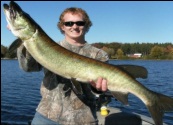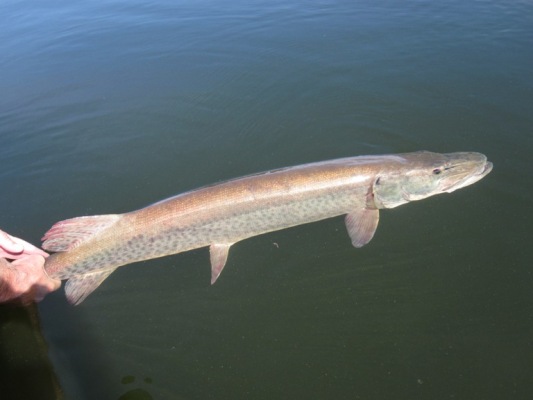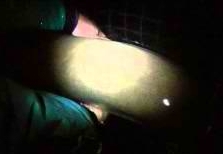|
|
Posts: 286
Location: Eagan, MN | How large is a musky's 'zone of awareness'?? In other words, the distance a musky is able to detect or sense objects in the water around itself?
Brian |
|
| |
|

Posts: 143
Location: La Crosse, WI | Herbie at AML said he's seen muskies move 30 feet to chase down a bucktail when related to rock. |
|
| |
|

Posts: 8849
| I think we're used to seeing and catching fish that are relatively inactive, requiring us to literally put a cast right on top of them to get a response. We've had days in clear water when fish were active where you could see them coming from a cast length away to chase down a lure. The amount of water they can cover in the blink of an eye is astounding. I'm not sure beyond that what their awareness zone is, but it's pretty safe to say that if you cover an area fairly well, every fish there knows your lure is there. |
|
| |
|
Posts: 1828
| I would assume it just has to do with water clarity for the visual, and then the sensitivity of their lateral line to pressure changes, i.e. sound.
I imagine underwater there is some variable amount of background noise, its magnitude dependent on conditions (currents, wave action, proximity to structure). So I think their ability to perceive the presence of something new has to do with how sensitive they are to pressure wave changes.
I'm assuming this is known and quantified somewhere for at least some types of fish, in the format of Intensity of Sound Perceivable vs Frequency of Sound.
For example, maybe they can sense and key in on a 2 dB (1.26 W/m^2) vibration if it's in the range of 60 - 200 Hz, but it has to be 8 dB or louder if it's a much lower frequency. (Arbitrary numbers)
Then in their environment, if there exists noise accumulating to say 80 dB at a whole mess of frequencies (white noise, sort of), then a new disturbance passes by such that the cumulative noise level is raised by 1 dB at their vantage point, then they can sense it only if their sensitivity threshold of "hearing" is 1 dB or lower at that specific frequency.
Then consider that sound intensity decreases exponentially as distance from the source increases. Go twice as far from the source, the sound intensity is four times less.
What's very interesting about this is considering bait loudness. Let's say double 10's are twice as loud as double 8's for some particular bucktail brand. Those 10's can be perceived at 1.41 times greater distance than the 8's.
So for sight, I think it's pretty cut & dried, dependent only on environmental light intensity, their eyes/brain, and water clarity.
But for vibrations, their 'zone of awareness' is totally dependent on:
background noise levels & frequencies
vibration source wave intensity & frequency
musky's sensitivity to vibrations
Maybe Big Bertha can feel a minnow pass by 10 ft away on a calm night when she's sitting still. But when she's cruising near a rock pile as the waves are crashing in, she might not not even feel your double cowgirl pass by 10 ft away. Hopefully she can see it! |
|
| |
|
Posts: 1299
Location: Hayward, Wisconsin | Don't forget their eyesight. I've seen muskies move 50 feet or more toward where the lure was headed...while it was still in the air!
Also, when tracking early on, we had a ping pong ball tied to the tail of the transmitter fish to get familiar with the tracking equipment. I once rounded a corner and spotted one of the males (spookiest) in the backend of a bay 150 yards away. I stopped the boat and stood up and he immediately took off! |
|
| |
|

Posts: 32945
Location: Rhinelander, Wisconsin | Remember also that vibration travels through water far faster and more efficiently than through air. 4800 feet per second. You already knew that if you swim much, it sounds like a boat is going to take you out and when you come to the top, it's hundreds of yards away.
Fish have about a 32 degree through window through which they can see above the water through the mirror effect created if it's calm if I remember my Sosin and Clark correctly. I'll go check.
If it's rough, the fish can't see through all the disturbances at the surface very well. |
|
| |
|

Posts: 1938
Location: Black Creek, WI | The old "John New" study shown that blind muskies could initiate an accurate strike on their prey at distances up to 3 times the length of their lateral line.
So... if a 50 incher is "blind" at night... it can successfully strike your lure from a distance of 9 feet assuming a 36" lateral line. That does NOT mean the fish couldn't sense the lure from a greater distance than that...
My personal conclusion from fishing muskies for 35+ years is that their Zone of Awareness is much larger than we think.  |
|
| |
|
Posts: 286
Location: Eagan, MN | So, which of their senses allows a musky to become precisely aware of our lure in the water from the greatest distance? Assume relatively clear water, would that be eyesight? Feel/lateral line stimulation? Sound?
Brian |
|
| |
|

Posts: 1938
Location: Black Creek, WI | Secci readings of the water clarity and light availability would control how far a musky can see. Constantly changing.
The New study suggested that vision was part of their "stalking" behavior. Perhaps how our lure LOOKS may play a role in whether a fish strikes or not? As for awareness... both senses are at play and environmental conditions will impact which one has the greatest "range".
Just my random thoughts..... |
|
| |
|
Posts: 1828
| I think about this a lot because I struggle with how many casts I need to place on "spots". I think I fish slower than most people because I hate the thought of not getting a bait close enough to a fish. Usually try to hit every 20' or so along a proven productive edge. So if it takes me 45 seconds per cast/retrieve/figure8/adjust, that means the boat should be moving about 0.3 mph.
But if an active fish can feel my bait from 50' away, then I wouldn't be so afraid of fishing a little faster. |
|
| |
|

Posts: 2754
Location: Mauston, Wisconsin | They have very good sight & hearing as for feeling the bait 50' away, I don't think its possible, as JLong said Dr John News study is fascinating.
http://jeb.biologists.org/content/204/6/1207.full.pdf
However, Dr Cheryl Coombs reseach in lateral lines and fish sensory systems are also very insightful.
http://personal.bgsu.edu/~scoombs/index.html
Including the possiblity that they can mask certain noises or lateral line stimulation. Basically same thing we do when wife is talking nonsense... I think they use the lateral line more in the figure 8 or in stained water. In Wabigoon its probably a combination of sound & lateral line with vision third. Steve W. might have insight on that.
By the same token, Like Larry R. on clear Canadian lakes I have had fish come up off the bottom like a rocket in 30-60 FOW. I usually prefer lures that stimulate all three sensory systems. However, in clear water vision seems to dominate as does the level of their spookiness. As Steve said, sound can work for or against you as can movement in the boat. There is a circle around them where they can see your movements above the surface, that is if they are not looking at the lure, the size of the circle depends on depth. Anyone who scuba dives has seen this effect.
My granddaughter had mid-fifties fish to the boat and she could clearly see the muskie's eyes looking at her and then back at the lure when she twitched it at the side of the boat. She was giggling playing with the fish! The fish eventually swam away. I told her to stop the lure 15-20 feet from the boat and twitch it if she saw a shadow behind it - ~ 5-10 casts later I hear huge splash behind me, turn to see her lure floating in huge boil - stupid fish missed the lure.
Have fun!
Al
|
|
| |
 Zone of Awareness
Zone of Awareness Zone of Awareness
Zone of Awareness